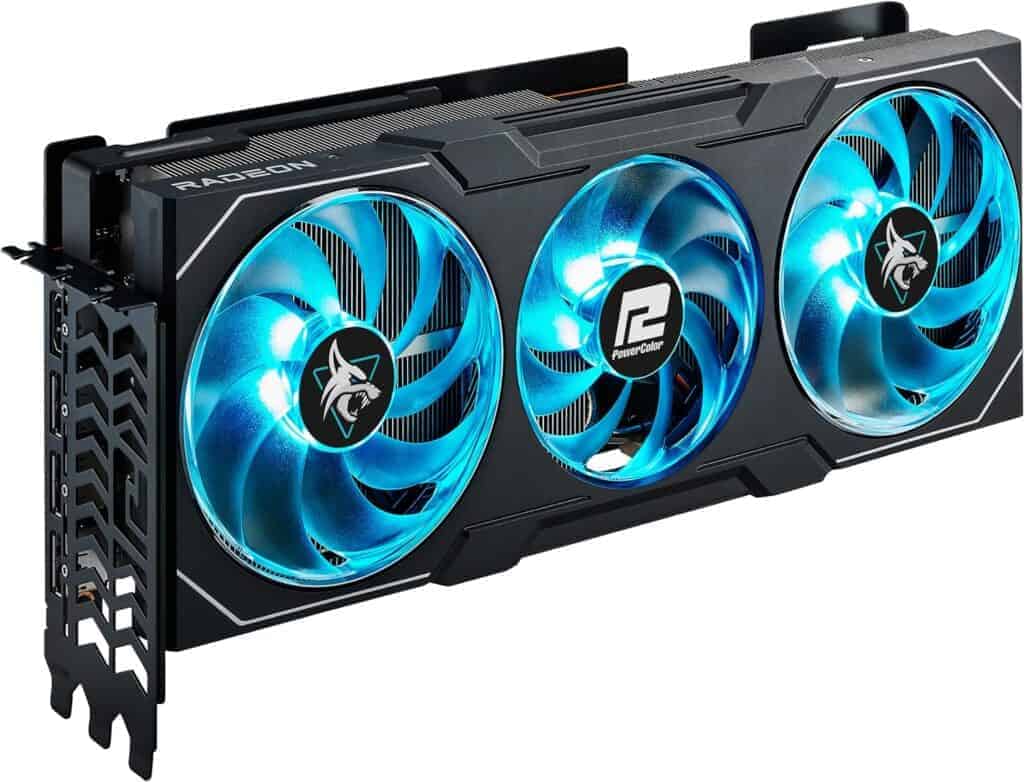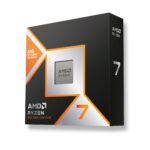The AMD Radeon RX 7000 Series brings powerful graphics to PC gaming. These new GPUs use RDNA 3 architecture for better performance and efficiency. The flagship RX 7900 XTX offers 24 GB of GDDR6 memory and 96 compute units for high-end gaming and content creation.
AMD’s latest graphics cards compete with NVIDIA’s RTX 40 series. They support features like ray tracing and AI-enhanced upscaling. The RX 7000 lineup spans from mid-range to enthusiast-level options.
Picking the right GPU depends on your needs and budget. Let’s look at the key specs of the top RX 7000 models:
| Model | Memory | Compute Units | Release Date |
|---|---|---|---|
| RX 7900 XTX | 24 GB | 96 | Dec 2022 |
| RX 7900 XT | 20 GB | 84 | Dec 2022 |
| RX 7600 | 8 GB | 32 | May 2023 |
AMD Radeon RX 7000 Series: A New Generation of Graphics
The AMD Radeon RX 7000 series GPUs, based on the RDNA 3 architecture, mark a significant leap in graphics technology. These cards bring impressive performance, advanced features, and improved efficiency to gamers and content creators.
Key Features and Improvements
- RDNA 3 Architecture: This new architecture boasts enhanced compute units, raytracing accelerators, and AI accelerators for a substantial performance boost and improved visual fidelity.
- Chiplet Design: AMD’s innovative chiplet design allows for increased performance and efficiency by combining different processing units on a single chip.
- GDDR6 Memory: High-speed GDDR6 memory provides ample bandwidth for smooth gameplay and demanding tasks.
- FidelityFX Super Resolution (FSR): Upscaling technology that boosts frame rates without sacrificing image quality.
- AV1 Encoding: Hardware-accelerated AV1 encoding for high-quality video streaming and recording.
- DisplayPort 2.1 Support: Enables high refresh rates and resolutions on the latest displays.
The Lineup
The RX 7000 series includes a range of GPUs to cater to different needs and budgets:
- RX 7900 XTX: The flagship model, offering top-tier performance for 4K gaming and demanding workloads.
- RX 7900 XT: A high-end option, delivering excellent performance at a slightly lower price point.
- RX 7800 XT: Aimed at enthusiast gamers, providing a great balance of performance and value.
- RX 7700 XT: Designed for 1440p gaming, offering smooth frame rates and high visual fidelity.
- RX 7600 XT: A more budget-friendly option, targeting 1080p gaming and esports.
- RX 7600: The entry-level model, offering solid performance for casual gamers.
| Model | Target Resolution | Key Features |
|---|---|---|
| RX 7900 XTX | 4K | Chiplet design, 24GB GDDR6 |
| RX 7900 XT | 4K | Chiplet design, 20GB GDDR6 |
| RX 7800 XT | 1440p/4K | 16GB GDDR6, high clock speeds |
| RX 7700 XT | 1440p | 12GB GDDR6, FSR support |
| RX 7600 XT | 1080p | 8GB GDDR6, AV1 encoding |
| RX 7600 | 1080p | 8GB GDDR6, efficient performance |
Performance and Comparisons
The RX 7000 series GPUs generally offer competitive performance compared to their NVIDIA counterparts. The higher-end models excel in rasterization performance, while ray tracing performance has also improved compared to previous generations.
Choosing the Right RX 7000 GPU
Consider these factors when choosing an RX 7000 series GPU:
- Target Resolution and Refresh Rate: Select a GPU that can handle your desired resolution and refresh rate.
- Types of Games: Demanding AAA titles or esports games?
- Budget: Determine how much you’re willing to spend.
- Features: Prioritize features like FSR, AV1 encoding, or DisplayPort 2.1 support.
Availability and Pricing
The RX 7000 series GPUs are available from various retailers and online stores. Prices vary depending on the model and specific configuration.
AMD Software: Adrenalin Edition
AMD’s Adrenalin Edition software provides a comprehensive suite of tools for managing and optimizing your RX 7000 series GPU. It includes features like:
- Driver updates: Keep your drivers up to date for optimal performance.
- Performance tuning: Adjust settings to fine-tune your GPU for specific games or applications.
- Game optimization: Access game-specific profiles and optimizations.
- Streaming and recording: Tools for capturing and streaming gameplay.
- Monitoring and diagnostics: Track GPU performance and identify potential issues.
Architecture and Technology
AMD’s Radeon RX 7000 series introduces groundbreaking advancements in GPU design. The new architecture brings significant improvements in performance and efficiency. It also incorporates cutting-edge features for enhanced gaming and compute capabilities.
RDNA 3 and Chiplet Design
The RDNA 3 architecture marks a major shift in GPU design. It adopts a chiplet-based approach similar to AMD’s Ryzen CPUs. This design allows for better scalability and efficiency.
Key features of RDNA 3:
- Modular design with separate Graphics Compute Die (GCD) and Memory Cache Die (MCD)
- GCD manufactured on TSMC N5 process
- MCD uses TSMC N6 process
The chiplet design enables AMD to mix and match different process nodes. This flexibility results in improved yields and potentially lower costs. It also allows for easier scalability across different GPU models.
7000 Series
- Radeon RX 7600
- Radeon RX 7600 XT
- Radeon RX 7700 XT
- Radeon RX 7800 XT
- Radeon RX 7900 GRE
- Radeon RX 7900 XT
- Radeon RX 7900 XTX
AI and Ray Accelerators
RDNA 3 introduces enhanced AI and ray tracing capabilities:
| Feature | Improvement |
|---|---|
| AI Accelerators | 2.7x faster AI operations |
| Ray Accelerators | 1.8x faster ray-triangle intersection |
These improvements boost performance in games using ray tracing and AI-enhanced features. The AI accelerators also benefit content creation tasks that leverage machine learning algorithms.
Infinity Cache and Memory
AMD’s Infinity Cache technology sees further refinement in RDNA 3:
- Up to 96MB of on-die cache
- Reduced latency and improved bandwidth
The Radeon RX 7000 series uses GDDR6 memory. This provides high bandwidth while maintaining power efficiency. The combination of Infinity Cache and GDDR6 memory results in effective bandwidth up to 3.5 TB/s.
These memory improvements help deliver smooth performance at high resolutions and framerates. They’re particularly beneficial for data-intensive tasks in gaming and content creation.
Performance and Gaming
AMD’s Radeon RX 7000 series graphics cards deliver impressive performance for modern gaming. These GPUs offer high frame rates and enhanced visual fidelity across a wide range of titles.
Benchmarking and FPS
The Radeon RX 7900 XTX stands out as AMD’s flagship model. It achieves over 100 FPS in many AAA games at 4K resolution with maximum settings. The RX 7900 XT follows closely behind, often reaching 90+ FPS in similar scenarios.
Benchmark results show these cards competing strongly against NVIDIA’s high-end offerings. In some titles, the 7900 XTX even outperforms the RTX 4080. However, performance can vary significantly between games.
| GPU Model | Avg 4K FPS (AAA Games) | Ray Tracing Performance |
|---|---|---|
| RX 7900 XTX | 100+ | Good |
| RX 7900 XT | 90+ | Good |
For 1440p gaming, both cards easily exceed 144 FPS in most titles. This makes them excellent choices for high refresh rate monitors.
Ray Tracing and FidelityFX Super Resolution
Ray tracing performance has improved significantly over previous generations. The RX 7000 series can now handle ray-traced effects with less of a performance hit. While still behind NVIDIA in some ray tracing scenarios, the gap has narrowed considerably.
AMD’s FidelityFX Super Resolution (FSR) technology enhances performance further. FSR 2.0 uses temporal upscaling to boost frame rates with minimal quality loss. This feature helps maintain smooth gameplay even with demanding ray tracing effects enabled.
FSR offers a compelling alternative to NVIDIA’s DLSS. It works across a wider range of GPUs and doesn’t require specialized hardware. Many games now support FSR, giving you more options to optimize performance and visual quality.
Models and Specifications
AMD’s Radeon RX 7000 series offers a range of graphics cards with varying performance levels and price points. These GPUs feature the latest RDNA 3 architecture, bringing improvements in speed and efficiency.
Radeon RX 7900 Series
The RX 7900 XTX is AMD’s flagship model, boasting 24GB of GDDR6 memory and 96 compute units. It delivers exceptional performance for 4K gaming and content creation. The RX 7900 XT, slightly less powerful, features 20GB of GDDR6 memory and 84 compute units.
Key specifications:
- RX 7900 XTX: 2.3 GHz game clock, 384-bit memory bus
- RX 7900 XT: 2.0 GHz game clock, 320-bit memory bus
Both cards support ray tracing and AMD’s FidelityFX Super Resolution technology for enhanced visuals.
Radeon RX 7800 and 7700 Series
The RX 7800 XT and RX 7700 XT target mid-range to high-end gaming experiences. These cards offer a balance between performance and affordability.
Specifications:
- RX 7800 XT: 16GB GDDR6 memory, 60 compute units
- RX 7700 XT: 12GB GDDR6 memory, 54 compute units
Both models support PCIe 4.0 and are suitable for 1440p gaming at high frame rates.
Pricing and Value
The RX 7900 XTX is priced at $999, while the RX 7900 XT costs $899. These prices position AMD’s top-tier cards competitively against NVIDIA’s offerings.
Mid-range options:
- RX 7800 XT: $499
- RX 7700 XT: $449
The RX 7600 XT, aimed at 1080p gaming, is available at a more budget-friendly price point of $329.
| Model | Memory | Compute Units | Price |
|---|---|---|---|
| RX 7900 XTX | 24GB | 96 | $999 |
| RX 7900 XT | 20GB | 84 | $899 |
| RX 7800 XT | 16GB | 60 | $499 |
| RX 7700 XT | 12GB | 54 | $449 |
AMD’s pricing strategy aims to offer strong performance-per-dollar value across its lineup.
Connectivity and Support
The AMD Radeon RX 7000 series offers robust connectivity options to enhance your gaming and content creation experience. These GPUs feature DisplayPort 2.1 technology, providing superior bandwidth for high-resolution displays and fast refresh rates.
You’ll benefit from frequent driver updates that optimize performance and add new features. AMD regularly releases new drivers to improve game compatibility and overall stability.
AMD Software: Adrenalin Edition is your central hub for managing your Radeon GPU. It offers a user-friendly interface to control settings, monitor performance, and access various features.
One notable feature is AMD Noise Suppression. This AI-powered tool reduces background noise during voice chats and recordings, ensuring clear communication while gaming or streaming.
The RX 7000 series also supports AV1 encoding, a cutting-edge video codec. This allows for better video quality at lower bitrates, ideal for content creators and streamers.
Here’s a quick overview of key connectivity and support features:
| Feature | Benefit |
|---|---|
| DisplayPort 2.1 | Higher bandwidth for 4K+ displays |
| Regular Driver Updates | Improved performance and compatibility |
| AMD Software | All-in-one control center |
| Noise Suppression | Clearer voice communication |
| AV1 Encode | Efficient video encoding for creators |
Frequently Asked Questions
The AMD Radeon RX 7000 series offers advanced graphics performance for gaming and professional use. These GPUs bring notable improvements in specifications, features, and pricing compared to previous generations.
What are the specifications of the AMD Radeon RX 7000 series GPUs?
The RX 7000 series is based on AMD’s RDNA 3 architecture, which uses a chiplet design combining 5nm and 6nm processes. This design allows for improved performance per watt compared to the previous generation.
The top-end model, the RX 7900 XTX, features 24GB of GDDR6 memory and a high number of compute units. Lower-tier models like the RX 7600 offer different configurations to suit various performance needs and price points.
How does the AMD Radeon RX 7000 series perform in gaming benchmarks?
Gaming performance varies by model, but the high-end RX 7900 XT offers comparable performance to NVIDIA’s RTX 4070 Ti. This makes it a strong choice for gamers seeking top-tier performance.
Lower-tier models in the series provide solid frame rates at their respective price points. Actual performance can vary depending on the specific game and settings used.
Are there any unique features in the AMD Radeon RX 7000 series, such as AI cores?
The RX 7000 series introduces several new features. While not specifically labeled as AI cores, these GPUs include hardware acceleration for certain AI-related tasks.
Key features include improved ray tracing capabilities and AMD’s FidelityFX Super Resolution technology for enhanced image quality. The series also supports AV1 encoding for improved streaming performance.
What are the price points for the various models within the AMD Radeon RX 7000 series?
Pricing varies across the RX 7000 series lineup. The high-end RX 7900 XTX and XT models launched at premium price points, while mid-range options like the RX 7600 offer more budget-friendly alternatives.
Exact prices can fluctuate based on market conditions and retailer promotions. It’s best to check current prices when making a purchase decision.
How do the AMD Radeon RX 7000 series GPUs compare with their predecessors?
The RX 7000 series offers significant improvements over the previous RX 6000 series. These include up to 54% better performance per watt, enhanced ray tracing capabilities, and improved power efficiency.
The new architecture also allows for better 4K gaming performance and improved content creation capabilities compared to the previous generation.
Have professional reviews highlighted any significant strengths or weaknesses of the AMD Radeon RX 7000 series?
Professional reviews generally praise the RX 7000 series for its strong gaming performance and competitive pricing. The improved ray tracing capabilities and power efficiency are often highlighted as strengths.
Some reviews note that NVIDIA still holds an edge in certain ray tracing scenarios. Driver stability and feature support are areas where AMD continues to make improvements.
| Model | Memory | Key Features |
|---|---|---|
| RX 7900 XTX | 24GB GDDR6 | Top performance, 4K gaming |
| RX 7900 XT | 20GB GDDR6 | High-end option, ray tracing |
| RX 7600 | 8GB GDDR6 | Mid-range, 1080p gaming |







